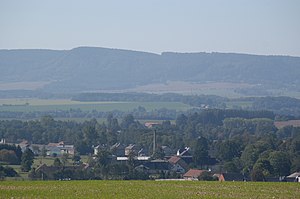Sázava u Lanškrouna
| Sázava | ||||
|---|---|---|---|---|
|
||||
| Basic data | ||||
| State : |
|
|||
| Region : | Pardubický kraj | |||
| District : | Ústí nad Orlicí | |||
| Area : | 567 ha | |||
| Geographic location : | 49 ° 54 ' N , 16 ° 39' E | |||
| Height: | 365 m nm | |||
| Residents : | 563 (Jan. 1, 2019) | |||
| Postal code : | 563 01 | |||
| structure | ||||
| Status: | local community | |||
| Districts: | 1 | |||
| administration | ||||
| Mayor : | Jiří Malátek (as of 2018) | |||
| Address: | Sázava 13 563 01 Lanškroun |
|||
| Municipality number: | 574392 | |||
| Website : | www.obec-sazava.cz | |||

WENZLVSLAVS RESLER ERBRICHTER IN ZOSO HAS DISE CABELLEN VUNSER LEBEN FRAVHEN TO HERBAVHEN LASEN 1681
Sázava (German Zohsee , also Zohsa, Zohsau, Elritzlich and 1304 Zasow and 1680 Zoose and 1681 Zoso ) is a municipality in the Czech Republic . It is located in Pardubický kraj (Czech Republic) east of the town of Lanškroun on the Moravská Sázava river and extends about 2.5 km from north to south. Historically, it belonged to the Schönhengstgau .
Neighboring places
The neighboring places are Albrechtice ( Olbersdorf ) and Žichlínek ( Sichelsdorf ).
history
The place was first mentioned in 1304 under the name Zasow :
"(..) derived from the river name Sazava , which was mentioned as aqua Zazauia (..) as early as 1275 (..) Sazava is an adjective based on -ava, neo-Czech -avá, for the noun saze-soot, sazavý-soot-colored, black ( ..) "
In 1304, a donation from several places in 1292 from King Wenceslaus II to the Königssaal monastery that he had founded was confirmed again. In 1322 there were two mills owned by the Landskron hereditary bailiff. In 1358 the monastery ceded the town of Zohsau (Zasow), among other things , as it was far away, as property to Johannes von Neumarkt , the Bishop of Naumburg , Leitomischl , Olmütz and Elekt von Breslau in exchange for other possessions and money. In 1508 and thereafter the name "Wüsten Zohsee" appeared. It is unclear what is meant by this, since Sázava was probably not "desolate" in the 16th century. The population of the village suffered heavily from the consequences of the Thirty Years' War (1618 to 1648) and the re-Catholicization . According to the latter, the residents were exclusively of the Roman Catholic denomination and belonged to the Landskroner Kirchensprengel and Dekanalamt.
According to an inscription on a column with a Pietà , Wenzelaus Reusler (Wenzel Rößler), who was the tester in Zohsee at the time, had a chapel built for Our Lady in 1681 or one year after the plague epidemic of 1680 . Presumably it was a wooden chapel, which was replaced in 1858 by a stone chapel dedicated to St. Procopius in the same place. A wooden bell tower also seems to have existed before, as the chapel's bell from 1858 supposedly came from 1542.
Population development
The community was since the 13./14. Century until 1945/46 predominantly inhabited by German Moravians .
“According to the table of findings from 1718, Zohsee had 23 farming properties. According to the ID from 1728 (..) there were already 22 houses and 5 residents and in 1789 eighty cottagers. In 1837 the place consisted of 106 houses with 628 German residents. "
The German-speaking population was expropriated and expelled after the Second World War on the basis of the Beneš decrees . As a result of the World War and the displacement , the population of the village fell from 489 inhabitants (1930) and from 438 (1939) to 369 in 1950. In 2014 Sázava had 572 permanent residents, in 2019 563. The number of inhabitants stabilized in the 21st century after the wars in the direction of the population around 1869.

politics
Community leader from 1850 to 1945
- 18xx-1858: Wenzel Langer, house number 75
- 1858–1864: Wenzel Janisch, house number 12
- 1864–1870: Johann Langer the Elder, house number 15
- 1870–1876: Karl Pelzl, house number 1
- 1876–1882: Franz Langer the Elder, house number 45
- 1882–1894: Hubert Müller, house number 32
- 1894–1908: Franz Langer the Younger, house number 45
- 1908–1919: Franz Richter, house number 4
- 1919–1922: August Frank, house number 1
- 1922–1925: Karl Neugebauer, house number 104
- 1925–1939: Johann Langer, house number 74
- 1939–1945: Josef Langer, house number 75
Attractions
- Column with Pietà from 1681
Web links
- Website of the municipality (Czech)
Individual evidence
- ↑ Český statistický úřad - The population of the Czech municipalities as of January 1, 2019 (PDF; 7.4 MiB)
- ↑ a b Gustav Korkisch: History of the Schönhengstgau. Part 1. (= publications of the Collegium Carolinum. Volume 20). Verlag Robert Lerche, Munich 1966, pp. 32–33.
- ^ A b Franz JC Gauglitz: home district Landskron. Home book for the city and district of Landskron. Compiled and edited. Zluhan, Bietigheim 1978. p. 262 ff.
- ↑ Joseph Eduard Ponfikl; Wenzel Natermus Streinz: Complete outline of a statistical topography of the Kingdom of Bohemia . Volume 3. Prague, 1828. p. 393
- ↑ 06 - House and population statistics . Internet: Zohsee in Schönhengstgau at www.zohsee.de. Accessed: August 18, 2019.


